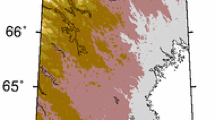Abstract
The computation of regional gravimetric geoid models with reasonable accuracy, in developing countries, with sparse data is a difficult task that needs great care. Here we investigate the procedure for gathering, evaluating and combining different data for the determination of a gravimetric geoid model for Iran, where limited ground gravity data are available. Heterogeneous data, including gravity anomalies, the high-resolution Shuttle Radar Topography Mission global digital terrain model and different global geopotential models including recently published Gravity Recovery and Climate Experiment models, are combined through least-squares modification of the Stokes formula. The new gravimetric geoid model, IRG04, agrees considerably better with GPS/levelling than any of the other recent local geoid model in the area. Its RMS fit with GPS/levelling is 0.27 m and 3.8 ppm in the absolute and relative view, respectively. The relative accuracy of IRG04 is four times better than the most recently published global and regional geoid models available in this area. This progress shows the practical potential of the method of least-squares modification of Stokes’s formula in combination with heterogeneous data for regional geoid determination
Similar content being viewed by others
References
Ardalan R, GrafarendE(2004) High resolution geoid computation without applying Stokes’s formula case study: high resolution geoid of Iran. J Geod 78:138-156
Featherstone WE (2003) Tests of two forms of Stokes’s integral using a synthetic gravity field based on spherical harmonics. In: Grafarend EW, Krumm FW, Schwarze VS (eds) Geodesy, the challenge of the third millenium. Springer, Berlin Heidelberg New York, pp 163–171
Hamesh M (1991) Technical report about adjustment of Iranian first order levelling network. NCC J Surveying 1:9–20
Hamesh M, Zomorrodian H (1992) Iranian gravimetric geoid determination-Second step. NCC J Surveying 6:17–24, 52–63
Hastings DA (1996) The global land 1-km base elevation (GLOBE) project. Boulder, Colorado National Geophysical Data Center
Kiamehr R (2001) Potential of Iranian geoid for GPS/Levelling. In: Proceedings of geomatics 80 conferences, National Cartographic Centre of Iran, Tehran, CD-ROM
Kiamehr R (2003a) Comparison relative accuracy of EGM96 and Iranian gravimetric geoid. In: Proceedings sixth international conference of civil engneering. Isfahan University of Technology, Iran, pp 537–544
Kiamehr R (2003b) Discussion about relative accuracy of IFAG geoid. J Sepehr Iranian Geographic Organization, 42:13–18
Kiamehr R (2004) The relative accuracies of recent satellite gravimetric models in Iran. In: Proceedings of IAG international symposium gravity, geoid and space missions – GGSM2004, Porto, Portugal, CD-ROM
Kiamehr R (2005) Qualification and refinement of the Iranian gravity database. In: Proceedings of geomatics 84 conferences, National Cartographic Centre of Iran, Tehran, CD-ROM
Kiamehr R, Sjöberg LE (2005a) The qualities of Iranian gravimetric geoid models versus recent gravity field missions. J SGG 49:289–304
Kiamehr R, Sjöberg LE (2005b) Effect of the SRTM global DEM in the determination of a high-resolution geoid model of Iran. J Geod 79(9):540–551
Kotsakis C, Sideris MG (1999) On the adjustment of combined GPS/levelling/geoid networks. J Geod 73(8):412–421
Lemoine F, Kenyon S, Factor J, Trimmer R, Pavlis N, Chinn D, Cox C, Klosko S, Luthcke S, Torrence M, Wang Y, Willimason R, Pavlis E, Rapp R, Olson T (1998) The development of the joint NASA GSFC and the National Imagery and Mapping Agency (NIMA) geopotential Model EGM96. NASA/TP1998206861
Najafi M (2004) Technical report of the KNT University geoid model. Department of research, National Cartographic Centre (NCC), TOTAK project, Iran
Paul NK (1973) A method of evaluating the truncation error coefficients for geoidal height. Bull Geod 110:413–425
Rapp R, Pavlis N (1990) The development and analysis of geopotential coefficient models to spherical harmonic degree 360. JGR 95(B13):0148–022
Sandwell DT, Smith WHF (1997) Marine gravity anomaly from Geosat and ERS 1 satellite altimetry. JGR 102(B5):10039–10054
Sjöberg LE (1984) Least squares modification of Stokes’ and Vening Meinesz’ formulas by accounting for truncation and potential coefficient errors. Manuscr Geod 9:209–229
Sjöberg LE (1986) Comparison of some methods of modifying Stokes formula. Presented at the International Symposium On the Definition of the Geoid, Florence, 26 30 May, 1986. Bollettino di Geodesia e Scienze Affini 3:229–248
Sjöberg LE (1991) Refined least squares modification of Stokes’ formula. Manuscr Geod 16:367–375
Sjöberg LE (2001) Topographic and atmospheric corrections of gravimetric geoid determination with special emphasis on the effects of degree zero and one. J Geod 75:283–290
Sjöberg LE (2003a) Improving modified Stokes’ formula by GOCE data. Boll Geod Sci Aff 61(3):215–225
Sjöberg LE (2003b) A computational scheme to model the geoid by the modified Stokes formula without gravity reductions. J Geod 74:255–268
Sjöberg LE (2003c) A general model of modifying Stokes’ formula and its least squares solution. J Geod 77:459–464
Sjöberg LE (2003d) A solution to the downward continuation effect on the geoid determined by Stokes’ formula. J Geod 77:94–100
Tapley B, Ries J, Bettadpur S, Chambers D, Cheng M, Condi F, Gunter B, Kang Z, Nagel P, Pastor R, Poole S, Wang F (2005) GGM02–an improved Earth gravity field model from GRACE. J Geod 79(8):467–478
Tscherning CC, Rapp R (1974) Closed covariance expressions for gravity anomalies, geoid undulations, and deflections of vertical implied by anomaly degree variance models. Report No 208, Department of Geodesy Science, Ohio State University, Columbus
Vaníček P, Najafi M, Martinec Z, Harrie L, Sjöberg LE (1995) Higher-degree reference field in the generalized Stokes–Helmert scheme for geoid computation. J Geod 70:176–182
Weber G, Zommorrodian H (1988) Regional geopotential model improvement for the regional Iranian geoid determination. Bullet Géodésique 62:125–141
Wenzel G (1985) Hochauflösende Kuglefunktionsmodelle für das Gravitationspotential der Erde. Wissenschaftliche Arbeiten der Fachrichtung Vermessungswesen der Universität Hannover Nr. 135
Author information
Authors and Affiliations
Corresponding author
Rights and permissions
About this article
Cite this article
Kiamehr, R. A strategy for determining the regional geoid by combining limited ground data with satellite-based global geopotential and topographical models: a case study of Iran. J Geodesy 79, 602–612 (2006). https://doi.org/10.1007/s00190-005-0009-5
Received:
Accepted:
Published:
Issue Date:
DOI: https://doi.org/10.1007/s00190-005-0009-5




